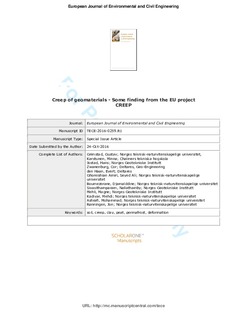Creep of geomaterials – some finding from the EU project CREEP
Grimstad, Gustav; Karstunen, Minna; Jostad, Hans Petter; Sivasithamparam, Nallathamby; Mehli, Magne; Zwanenburg, Cor; Evert, den Haan; Ghoreishian Amiri, Seyed Ali; Boumezerane, Djamalddine; Kadivar, Mehdi; Haji Ashrafi, Mohammad Ali; Rønningen, Jon A.
Journal article, Peer reviewed
Accepted version
Permanent lenke
http://hdl.handle.net/11250/2470520Utgivelsesdato
2017Metadata
Vis full innførselSamlinger
Originalversjon
European Journal of Environmental and Civil Engineering. 2017, . 10.1080/19648189.2016.1271360Sammendrag
This paper gives a summary of some of the main findings of the EU founded project “Creep of geomaterials”, CREEP. CREEP was an Industry-Academia Partnerships and Pathways (IAPP) project funded from the 7th Framework Programme (FP7/2007–2013) of the EC under grant agreement PIAG-GA-2011-286397. The project aimed at establishing a consensus in creep modelling within geotechnical engineering. The materials studied were clay, peat and frozen soils (permafrost). Throughout the project, research on material behaviour in laboratory and field studies was combined with numerical studies using existing and newly developed mathematical frameworks. This paper summarises some of the findings in the project, although the focus is on the developments in the field of soft soils and soft clay in particular. The paper presents a unified enhanced soft clay creep model, which takes into account anisotropy, structure and rate dependency of the material. The performance of the model is demonstrated through analysis of the Murro test embankment. In addition, the paper gives an overview of some characteristics for frozen soil and peat. Some of the considerations regarding, e.g. over consolidation ratio for clay with respect to strain rate are very much valid for peat and frozen soil as well.
